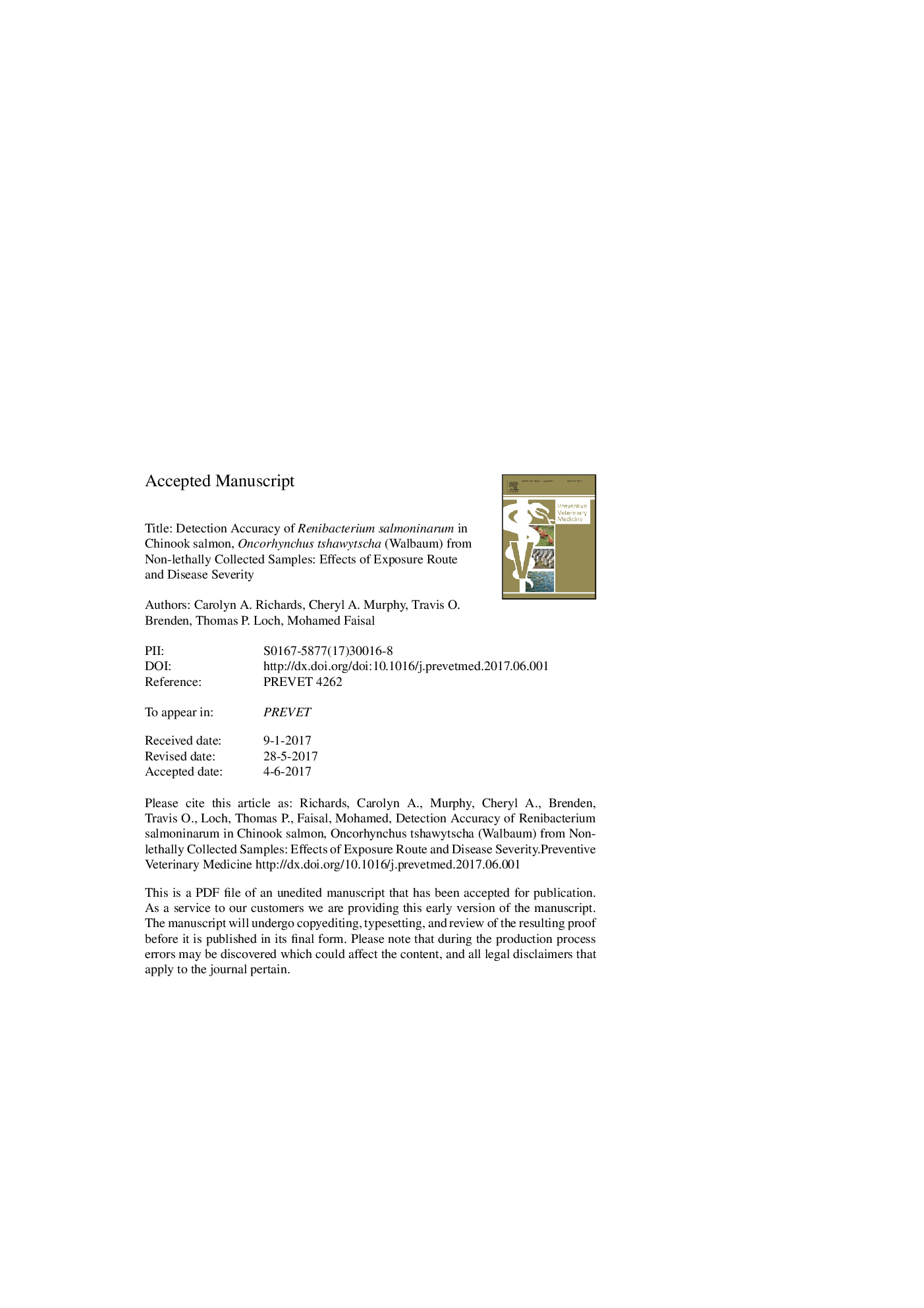| کد مقاله | کد نشریه | سال انتشار | مقاله انگلیسی | نسخه تمام متن |
|---|---|---|---|---|
| 5543548 | 1554145 | 2017 | 42 صفحه PDF | دانلود رایگان |
عنوان انگلیسی مقاله ISI
Detection accuracy of Renibacterium salmoninarum in Chinook salmon, Oncorhynchus tshawytscha (Walbaum) from non-lethally collected samples: Effects of exposure route and disease severity
دانلود مقاله + سفارش ترجمه
دانلود مقاله ISI انگلیسی
رایگان برای ایرانیان
کلمات کلیدی
موضوعات مرتبط
علوم زیستی و بیوفناوری
علوم کشاورزی و بیولوژیک
علوم دامی و جانورشناسی
پیش نمایش صفحه اول مقاله

چکیده انگلیسی
Bacterial kidney disease (BKD), caused by Renibacterium salmoninarum, threatens salmonid populations throughout the Northern hemisphere. Many fishery regulatory authorities require ongoing disease monitoring in hatcheries and spawning runs prior to gamete collection to prevent BKD outbreaks and spread. According to diagnostic protocols of the American Fisheries Society-Fish Health Section, monitoring for R. salmoninarum generally consists of lethal sampling of visceral organs from fish. However, non-lethal sampling would be preferable, especially for valuable broodstock or endangered species. In this study, non-lethal sampling methods were evaluated for their ability to detect R. salmoninarum in Chinook salmon (Oncorhynchus tshawytscha) that were experimentally infected via two different routes (e.g., intraperitoneal injection and waterborne immersion) to mimic acute and chronic disease courses. Non-lethal (e.g., blood, mucus, and a urine/feces mixture) and lethal (e.g., kidney and spleen homogenate) samples were collected from challenged and mock-challenged Chinook salmon and the presence of R. salmoninarum was assessed by culture on modified kidney disease medium, nested polymerase chain reaction (nPCR), and semi-quantitative enzyme-linked immunosorbent assay (ELISA). Sensitivity, specificity, and accuracy of lethal and non-lethal samples in detecting R. salmoninarum were calculated using receiver operating characteristic (ROC) analyses. For ROC analyses, true disease status was evaluated under two different assumptions: 1) that lethal samples represented the true disease status and 2) that all experimentally challenged fish were truly infected. We found that sensitivity and specificity of non-lethal samples depended upon time of sampling after experimental infection, sample type, and R. salmoninarum exposure route. Uro-fecal samples had the greatest potential as non-lethal samples compared to mucus and blood. In terms of future monitoring, combining lethal samples tested by ELISA assay with uro-fecal samples tested by nPCR could be the best strategy for detecting R. salmoninarum prevalence in a population as it reduces the overall number of fish required for sampling.
ناشر
Database: Elsevier - ScienceDirect (ساینس دایرکت)
Journal: Preventive Veterinary Medicine - Volume 145, 15 September 2017, Pages 110-120
Journal: Preventive Veterinary Medicine - Volume 145, 15 September 2017, Pages 110-120
نویسندگان
Carolyn A. Richards, Cheryl A. Murphy, Travis O. Brenden, Thomas P. Loch, Mohamed Faisal,